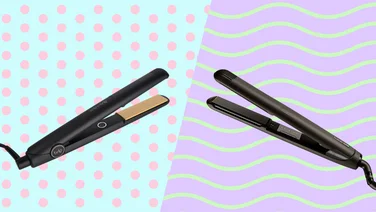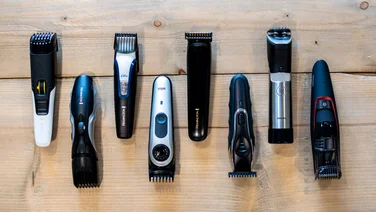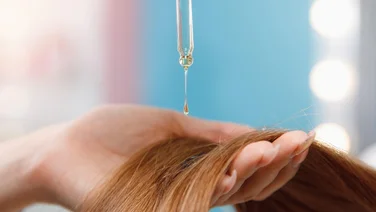To help us provide you with free impartial advice, we may earn a commission if you buy through links on our site. Learn more

Understanding your hair type is key to taking care of your hair and getting your routine right. There are four main types of hair: straight, wavy, curly, and kinky/coily. Let’s break down these types, how to recognise yours and what works best for your hair.
Your hair type is determined by the shape of your hair follicle, which is largely influenced by genetics. This influences the angle at which hair grows out of the scalp and, ultimately, your hair type and texture. Environmental factors and certain treatments or processes like chemical straightening can temporarily alter hair texture. However, it’s the natural shape of the hair follicle that determines what hair type you have, along with proteins like keratin in the hair.
If you’re looking to understand your hair type to start building your perfect hair care routine, there are some ways to identify your hair type. Let’s start by looking at the most common hair types.
READ NEXT: The best shampoo and conditioners
What hair types are there?
There are four main hair types: straight, wavy, curly and kinky/coily. Some people can have a mixture of hair types and curl patterns.
Straight hair

Straight hair looks smooth and doesn’t have any significant waves or curls. It tends to be shiny and reflects light easily because of its flat structure. Straight hair has a round follicle, meaning that the hair grows out in a straight, uniform manner without any bends or curves along the hair shaft. It can be easier to style than textured hair but might lack volume or become oily more easily.
READ NEXT: The best heated rollers
Wavy hair

Wavy hair falls between straight and curly. It has gentle, loose curls or waves that form an ‘S’ shape, and some parts may be more wavy, curly or straight than other areas of the hair. Wavy hair is caused by a more oval or elongated hair follicle than straight hair. This hair type can range from slight bends to more defined waves, providing natural volume and texture. Wavy hair can sometimes be prone to frizz and might need specific care to maintain its shape and definition.
READ NEXT: The best anti-dandruff shampoo
Curly hair

Curly hair has a distinct shape, ranging from loose curls to tight ringlets. There are different subtypes of curly hair, like Type 3A (loose curls) to Type 4C (tight coils), each with its unique look, characteristics and routines. Curly hair usually has more volume and body thanks to the natural bounce of the curls. This hair type is often drier because the natural oils from the scalp struggle to travel down the spiral shape of the hair strands, making it more prone to frizz and tangles. Hair follicles that are curved or hooked produce curly hair – the more pronounced the curve, the tighter the curl pattern is.
READ NEXT: The best products for curly hair
Kinky/coily hair

This hair type has tightly coiled or zig-zag patterns, forming tight curls or coils close to the scalp. It’s the most fragile and prone to dryness and breakage among the hair types because the natural oils have the most difficulty travelling along the bends of the hair strands. Hair follicles that are flat or ribbon-like in shape produce kinky or coily hair. These flattened follicles cause the hair to grow in a spiral or zig-zag pattern, resulting in tight curls or coils close to the scalp.
READ NEXT: The best hairbrush
How to find your hair type
If you’re confused about what your hair type is, or none of the descriptions quite match up to your hair type, you might need to review your texture, curl pattern and how your hair dries.
Start by assessing the thickness of your individual hair strands. Hold a single strand between your fingers. If it feels thin and barely noticeable, you likely have fine hair. If it feels coarse or thick, your hair is considered thick or coarse. Thick or coarse hair is more common with curly, kinky or coily hair, but all hair types can have fine strands.Then, take a closer look at your curl pattern and observe how your hair naturally behaves when it’s free from styling products or treatments. Remember, you can have a few different curl patterns all in one, making it trickier to tell your hair type sometimes. Check out how your hair dries naturally without products in it.
If it doesn’t have any curls or waves, then it might be that your hair is straight. Wavy hair forms gentle, S-shaped waves or loose curls, whereas with curly hair, you might see more defined curls or spirals – these could be loose and bouncy curls through to defined coils. Coily or kinky hair has tightly coiled or zig-zag patterns. It often shrinks in length and has a characteristic texture.
You should also look at how your hair responds to different styling methods, products and environmental factors like humidity. This can offer insights into its texture and curl pattern. It’s also common for hair texture and type to change over time due to factors like ageing, hormonal changes and environmental influences.
READ NEXT: The best hair thickening products
What can affect your hair type?
While genetics and your heritage are the main factors that determine your hair type, there are some other factors that can affect it.
Hormonal fluctuations, such as those occurring during puberty, pregnancy or menopause, can impact hair texture and behaviour. For example, some women may experience changes in their hair’s curl pattern during pregnancy or notice increased hair shedding postpartum due to hormonal shifts. Hormones can affect the hair growth cycle, leading to temporary changes in texture, thickness or even hair loss. Medical treatments such as chemotherapy can also affect your hair type and curl pattern.
The environment can affect your hair type, too. Humidity, pollution and UV exposure can affect the health and appearance of your hair. Environmental stressors can make hair more susceptible to damage and change its texture over time.
Chemical treatments like perms, relaxers, colouring and heat styling tools can significantly impact hair type. Permanently altering the hair’s structure through chemical treatments can change its texture from straight to curly or vice versa. Continuous use of heat styling tools without proper protection can also lead to heat damage, resulting in changes in the hair’s texture, making it more brittle, frizzy or prone to breakage. These changes are usually temporary until your hair grows out.






